
A squid is a mollusc with an elongated soft body, large eyes, eight arms, and two tentacles in the superorder Decapodiformes, though many other molluscs within the broader Neocoleoidea are also called squid despite not strictly fitting these criteria. Like all other cephalopods, squid have a distinct head, bilateral symmetry, and a mantle. They are mainly soft-bodied, like octopuses, but have a small internal skeleton in the form of a rod-like gladius or pen, made of chitin.

A cephalopod is any member of the molluscan class Cephalopoda such as a squid, octopus, cuttlefish, or nautilus. These exclusively marine animals are characterized by bilateral body symmetry, a prominent head, and a set of arms or tentacles modified from the primitive molluscan foot. Fishers sometimes call cephalopods "inkfish", referring to their common ability to squirt ink. The study of cephalopods is a branch of malacology known as teuthology.

The yellow-eyed penguin, known also as hoiho or tarakaka, is a species of penguin endemic to New Zealand.

The Fiordland penguin, also known as the Fiordlandcrested penguin, is a crested penguin species endemic to New Zealand. It currently breeds along the south-western coasts of New Zealand's South Island as well as on Stewart Island/Rakiura and its outlying islands. Because it originally ranged beyond Fiordland, it is sometimes referred to as the New Zealand crested penguin. It is occasionally found in Australia.

Ommastrephidae is a family of squid containing three subfamilies, 11 genera, and over 20 species. They are widely distributed globally and are extensively fished for food. One species, Todarodes pacificus, comprised around half of the world's cephalopod catch annually.

Psychroteuthis glacialis, the glacial squid, is the only known species in the monotypic genus Psychroteuthis, in the family Psychroteuthidae. While only one species has been confirmed, two undescribed species also probably exist. The species occurs in coastal waters near Antarctica and South America. It grows to a mantle length of 44 cm (1.44 ft).
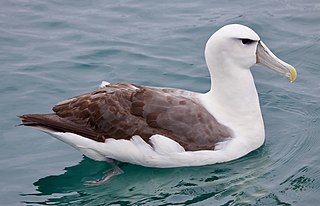
The white-capped albatross is a mollymawk that breeds on the islands off of New Zealand. Not all experts agree that this form should be recognized as a separate species from the shy albatross, Thalassarche cauta. It is a medium-sized black, slate gray, and white albatross and is the largest of the mollymawks.

Abralia is a genus of squid comprising around 20 species from the family Enoploteuthidae. They are small squid which can be found in the epipelagic to mesopelagic zones while some species are found in water with shallow substrates on steep slopes on the boundary of the mesopelagic zone. They are distinguished from other members of the Enoploteuthidae by not normally having large, black photophores at the tips of arms IV, although if these are present they are not covered in black chromatophores, and having fins which extend beyond their tail. The photophores of the integument are characteristicand are found in the three types. "Lensed" photophores are a blue color with a white ring, "simple" photophores are small and violet-colored and the "complex" photophores are surrounded by small green satellite points and have a green centre. The complex photophores will frequently appear to be blue depending on their physiological state. The integument also has small black chromatophores which look like dots. They have 5-12 variably sized photophores on the eye. Either the right or left arm IV is hectocotylized.
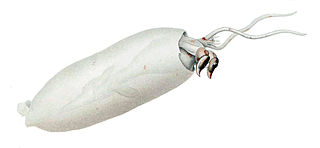
Taoniinae is a subfamily containing ten genera of glass squids.

Onychoteuthis banksii, the common clubhook squid, is a species of squid in the family Onychoteuthidae. It is the type species of the genus Onychoteuthis. This species was thought to have a worldwide distribution but with the revision of the genus Onychoteuthis in 2010, it is now accepted that Onychoteuthis banksii is restricted to the central and northern Atlantic and the Gulf of Mexico while a recently described species, Onychoteuthis horstkottei, is found in the Pacific Ocean. The type locality is the Gulf of Guinea.

Xipholeptos is a genus of squid in the family Idiosepiidae. It is monotypic, being represented by the single species Xipholeptos notoides, commonly known as the southern pygmy squid. The species was originally classified as Idiosepius notoides. The southern pygmy squid is native to the southwestern Pacific Ocean, off southern and eastern Australia. It inhabits shallow, inshore waters. It has been recorded off the coasts of New South Wales, South Australia, Tasmania and Victoria.
Moroteuthopsis longimana, also known as the giant warty squid or longarm octopus squid, is a large species of hooked squid. It attains a mantle length of at least 85 cm and probably over 1.15 m. The largest complete specimen of this species, measuring 2.3 m in total length, was found in Antarctica in 2000.
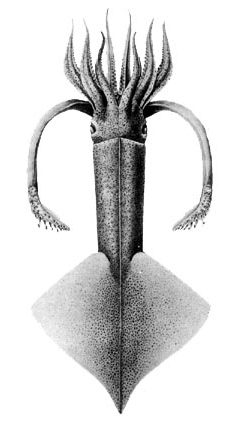
Onychoteuthis is a genus of squid in the family Onychoteuthidae. The type species is Onychoteuthis bergii. While the genus is found worldwide in tropical and subtropical oceans, they can also occur in the North Pacific Ocean. There were previously considered to be four species in the genus but there are now considered to be roughly 10. These squid are frequently observed in the surface waters at night and they are often caught using dipnet at nightlight stations. The young squid are usually the only specimens captured using standard midwater trawls, the older squid are apparently able to avoid the trawls. They can, however be collected from the air as individuals are able to leap high out of the water, sometimes even landing on the deck of a ship.
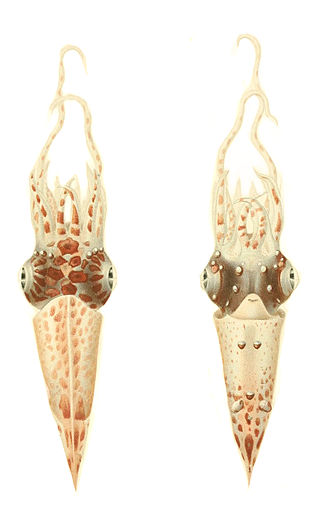
Pterygioteuthis giardi is a species of squid in the family Pyroteuthidae. It is known as the roundear enope squid. The specific name honors the French zoologist and marine biologist Alfred Mathieu Giard (1846-1908).

Nototodarus sloanii is a species of squid commonly known as the New Zealand arrow squid or Wellington flying squid. It is also known by its Māori name of wheketere. It is a favoured prey species of a number of marine mammals and diving birds. It is an important food source for the New Zealand fur seal and two endangered species: the New Zealand sea lion and the yellow-eyed penguin. N. sloanii is sought by trawler fishermen for human consumption; New Zealand sea lions are frequently caught in trawl nets and drowned when feeding on N. sloanii.

Todarodinae is a squid subfamily in the family Ommastrephidae.

Martialia hyadesii is a species of flying squid commonly known as the sevenstar flying squid.

Stigmatoteuthis is a genus of squid from the family Histioteuthidae. They occur in the Oceans from the tropics south to the temperate seas.
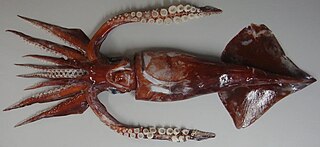
Todarodes is a genus of flying squid from the subfamily Todarodinae, of which it is the type genus. The genus contains five species which are partially allopatric but between them their distributions encompass most of the world's oceans and seas. These squid have a funnel groove with foveola, a hectocotylised fourth arm and tentacular stalks which lack free trabeculae.

Octopus vitiensis, or the bighead octopus, is a species of octopus provisionally placed in the genus Octopus. It was described by William Evans Hoyle in 1885 based on a specimen found in reefs in Kandavu, Fiji during a voyage of HMS Challenger.



















